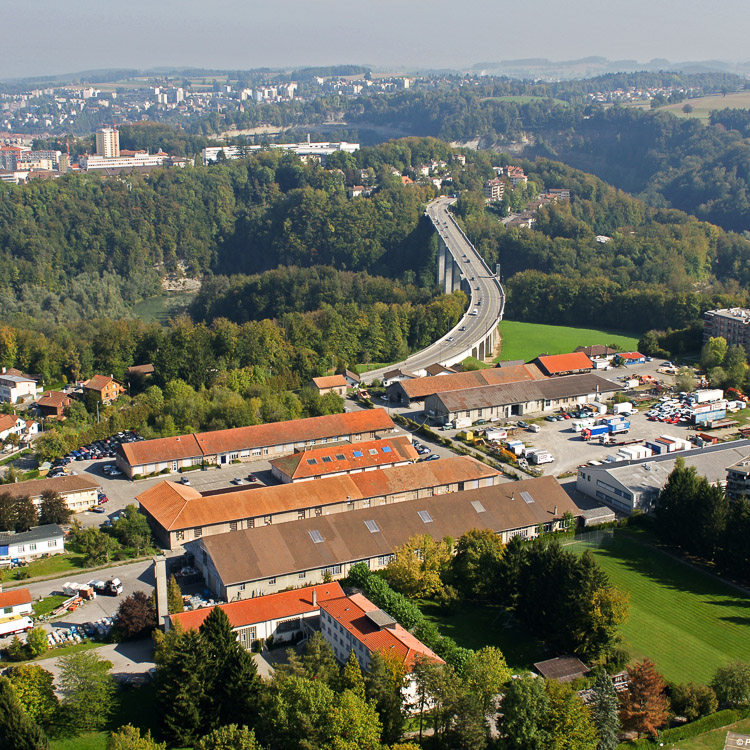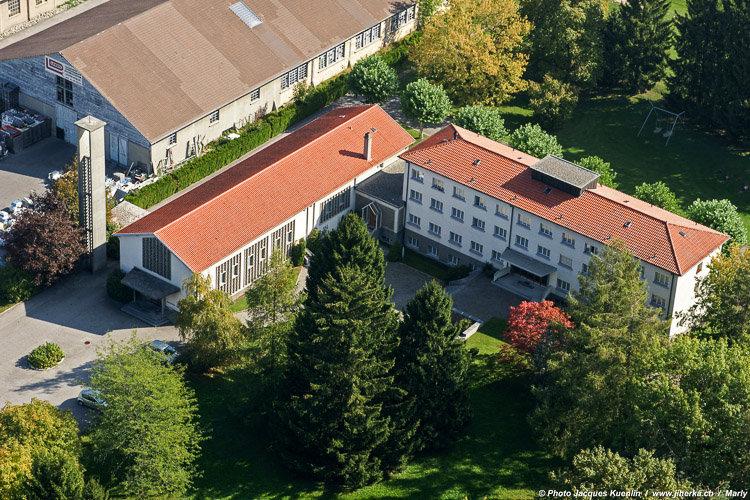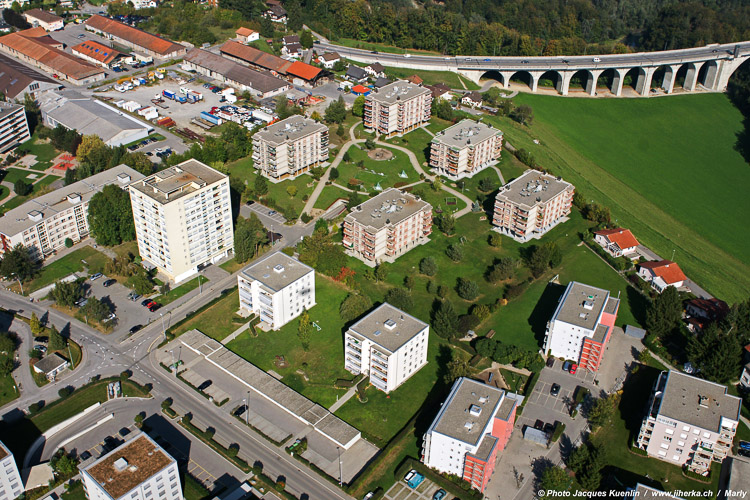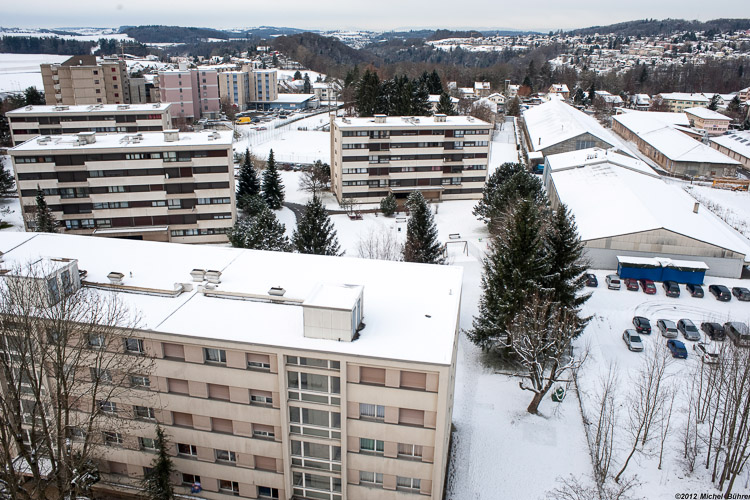Marly
The Synthetic Site Folder and Site Brief are available for free.
Please register and login to access the Complete Site Folder.
- Synthetic site folder DE | EN | FR
- Site on Google Maps
- Back to map
Data

Category Planning - architectural
Team representative Architect - Urban planner - landscaper
Location MARLY/FR - Sites: Winckler and Saint-Sacrement (Blessed Sacrament), redevelopment of the northern entrance
Population 7,900 inhabitants
Strategic site 23 ha - Site of project 4.5 ha (Winckler) - 1.7 ha (Saint-Sacrement)
Site proposed by Town of Marly
Owners of the site Several private landowners, the municipality has a right of first refusal on the site of the Saint-Sacrement (1.7 ha)
Commission after competition a Master Plan and detailed development plans.
More Information
How can the site contribute to the adaptable city?
The Winckler activity site and the Saint-Sacrement site are located north of the town; they are bordered to the west by the Cantonal road linking Marly to Fribourg. During recent years housing expanded around the sites that still contain dilapidated industrial buildings. West of the site, on the other side of the Cantonal road, individual housing was developed while in the South and East apartment buildings were built.
The municipality wants the project to be a showcase development project for the area, favoring an urban zone along the main road and a mixed zone in the rest of the perimeter.
City strategy
The project objectives are to provide a quality environment for future residents and users of the area that must appear as an extension of the village and contribute to enhance the northern entrance to Marly and the public spaces.
The town wants a renewal and densification of the existing built areas in connection with the Fribourg road. This is also an opportunity to redefine the thoroughfare for which a re-development project with a roundabout access to Winckler - Saint-Sacrement sites is already planned for 2015.
The reflection should lead to a search for density based on a mass ratio between the building and public and semi-public space, enhancing the dynamics of the site and the connectivity with neighboring areas. All of this must be included in the action plan set out in the 2nd Generation Master Plan (PDA2).
The right density will be defined by the quality of the public space in the district and the quality of the accesses.
On the site of the Saint-Sacrement, the Town has a right of first refusal under an agreement signed in 2004 with the Fathers who own the site.
One of the conditions for the acquisition of the land by the City is that fathers can spend the rest of their lives in the house where they live now.
There are still eight of them, aged from 82 to 96 years. This site is occupied by a house and a church with a steeple.
Half of the site is located in an “Area of General Interest” and the other half in a green zone.
The “Area of General Interest” must be kept to comply with the terms of the Urban Development Plan which plans the extension of the main thoroughfare to Marly.
Site definition
Like many Swiss rural towns Marly enjoyed a major industrial development in the 19th and especially in the 20th century. The industrial activity came as an addition to traditional farming activities.
Marly’s growth resulted in better living standards and a population increase. Unfortunately, the successive economic crises of the 20th century destroyed some major industrial concerns. The Winckler Company was among the casualties and went out of business in 1981.
However, Marly remained an industrial town with activities in watch making, cosmetics and in the beginning of the sixties, the arrival of the Ciba Company.
The proximity of Fribourg contributes to a better quality of life for the Marly inhabitants with easy access to a city that provides jobs, cultural and recreational activities.
Adaptability: main challenges to take into account
Transport and mobility:
Marly is located on the Bulle to Fribourg thoroughfare, and is served by a network of regional and urban bus lines. A regular bus line runs between Marly and the Fribourg railway station with a 10 minute frequency (a trip of 5 minutes) in correspondence with Intercity trains from the CFF.
Marly is one of 10 municipalities of the Fribourg Metropolitan area that has developed a comprehensive mobility policy, promoting alternative mobility with the development of services like: P + R (Park and Ride), free bicycles, carpooling, etc ...
Development proposals should reinforce that mobility policy.
New lifestyles:
The town of Marly wants an exemplary new district to be built on the sites combining housing and business activities integrated in a contemporary vision of the future built areas, which must be attractive to both new businesses and new residents.
In this context, public spaces connected to the village and the neighboring districts must play a role.
New environment sustainability:
The foundations of a sustainable development are to be found in the immediate vicinity of Marly.
The overwhelming presence of nature must be integrated naturally into the building designs and public spaces while taking advantage of the presence of the Sarine River.
This philosophy can be expressed in the planning and construction stages of the project as well as in the energy management program for the whole site.




Questions on the site
Is it possible to get the blue prints and the elevations/ sections of the buildings in the Winckler site (other than those from the ASFL)?
Theoretically, we should have the plans. However - assuming that only the ASFL and Saint Sacrament buildings will be kept - the blue prints are already in the competition folder. If candidates need the plans of a specific building, they must tell us which building it is and the requested format (paper, pdf, dwg, dxf, etc.)
Where are the contour lines in the dwg files? There is an overlay but it is empty
See document MARLY-CH-SS-M5.dwg.
In the description of the program (page n°6), you write "The town of Marly does not show any sign of significant saturation of its infrastructure such as schools, sanitation station, etc. However, during the course of the project, some deficiencies will be addressed to improve the image of the urban limits by incorporating the “silhouette concept” to be used in the specifications for future projects and ensure a harmonious and flexible development of the Site." what do you mean when you talk about the "silhouette concept", what is its role? What kind of deficiencies we have to address to improve the urban limits by incorporating so called “silhouette concept”?
The idea is to define an outer perimeter with a roadside view that gives a harmonious picture of Marly or at least to plan the future urban contours. Mr. Boéchat talked about extending the Boulevard de Pérolles. The ultimate goal is to sketch the future cantonal road side.
is it possible to have the MARLY-CH-PS-M10.dwg file?
Yes, see document MARLY-CH-SS-M5.dwg.
Could you please tell us the real functions of each building in the project area?
The list of the companies and their business activities may be found in the document MARLY-CH-PS-M24.PDF under “0-New_docs_after_launch”.
What do you mean when you say that every demolished building, in the project area, has to be replaced? Do we have to replace exactly the same buildings in a different place?
No we never said that. The buildings that will be demolished are not to be replaced. Nevertheless, if the ASFL buidlding (N°28) was to be demolished, a replacement solution should be found in the site, at no cost to the owners (ASFL).
Is it possible to have the blue prints of the other buildings of the industrial wasteland?
We are supposed to have the plans. However - assuming that only the ASFL and Blessed Sacrament buildings will be kept, the plans are already included in the competition folder. If candidates need the plans of a particular building, they must tell us which one and the requested plan format (paper, pdf, dwg, dxf, etc.).
During the site tour, nothing was said of the Urban development Regulations of the town of Marly. Do we have to comply with the current specifications (maximum building height, building permit, materials, etc.) or, could specific urban regulations be considered for the study site?
As we are in a PAD area, sector-specific regulation may be enacted.
Is it possible to have the file MARLY-CH-PS-M6 in dwg format?
Yes, see document MARLY-CH-PS-M6.dwg.
Can we have more information about existing building? The height, their functions, etc. Is there only one owner of the existing buildings?
This is not needed as the buildings are going to be torn down. But if this appears to be definately needed to deliver thorough proposals, the information will be provided.
There are ten landowners.
Is it possible to have the file MARLY-CH-PS-M6 in dwg format?
Yes, see document MARLY-CH-PS-M6.dwg.
is the project of the new roundabout strictly binding?
Yes.
What will be the mandate/mission awarded to the winning team?
The information is in the competition folder: Commission after competition: a Master Plan and detailed development plans.
In the MARLY-CH-PS-M6.pdf file we can find the project of the new roundabout and of the new bus lane along the Fribourg road. Do we have to consider these two elements (new roundabout + new bus lane) as a matter of facts? Must they be considered "real", as existing things? can we have the MARLY-CH-PS-M6.dwg file?
Yes, but you can make an alternate proposal.
Yes, see folder “0-New_docs_after_launch”.
Do we have to provide a replacement solution for each building in the area or only for buildings n° 28/16/30?
Only the buildings n° 16, 18 and 28 will be preserved. An alternate proposal could be made for the ASFL (N°28). This is mentioned I the site folder.
Can we suggest the refurbishing of each building in the area?
No.
Where is the program, defining the wanted uses, density, and buildings to keep? I haven't found it in the site folder.
Only buildings n° 16, 18 and 28 will be preserved. An alternate proposal could be made for the ASFL (n° 28). This is mentioned in the site folder. You can find the Land Use Plan (PAZ) and the Municipal Urban Planning Regulation (RCU) here.
Could we get plans, sections and elevations of the buildings number 26, 36, 42 and 48?
As the buildings are going to be torn down we do not have any plans available.
Is it possible to get the blue prints of the buildings, especially those of the production halls (buildings N°48, 50c, 50a, 42, 38, 36 and 26) as well as the blue prints of building N°32 and -if available- of buildings N°68 and 40e?
As the buildings are going to be torn down we do not have any plans available.
Where can we find the file MARLY-CH-PS-M6.dwg?
See under www.europan-europe.eu “0-New_docs_after_launch”.
Where is the MARLY-CH-PS-M6.dwg document/ file (drawing of the Rittes crossroad)? It is not in the complete site folder.
See under www.europan-europe.eu “0-New_docs_after_launch”.
Can we have the MARLY-CH-PS-M6.dwg file, please? We can't find it in the download section.
Yes, to see under www.europan-europe.eu “0-New_docs_after_launch”.
Could we get plans, sections and elevations of the buildings number 26, 36, 42 and 48? Could we get elevations and sections of the church as well?
Only the buildings n° 16, 18 and 28 will be preserved. An alternate proposal could be made for the ASFL (N°28). This is mentioned I the site folder.
For the Church plans see file MARLY-CH-PS-M20.PDF, MARLY-CH-PS-M21.PDF, MARLY-CH-PS-M22.PDF and MARLY-CH-PS-M23.PDF.
As explained in the brief, “The Swiss Confederation, the Canton and the Fribourg Metropolitan Authority define development elements such as the density of the built environment, limits of the authorized built areas, increasing public transport availability, promoting soft mobility, etc. All this must be part of this project”. Could we get this information?
Candidates can find the Land Use Plan (PAZ) and the Municipal Urban Planning Regulation (RCU) here.
The map of the Metropolitan area here, here and here.
The area is subject to a PAD (deferred urban development plan), therefore, density rules may be changed and adjusted to the site requirements.
Where can we get the PDA2?
You can find the Land Use Plan (PAZ) and the Municipal Urban Planning Regulation (RCU) here.
Is it possible to get the regulations attached to the PAZ in order to have a description of each zone?
You can find the Land Use Plan (PAZ) and the Municipal Urban Planning Regulation (RCU) here.
Is compliance with the land use plan, a mandatory requirement?
Yes, the candidates can increase the density and the height of the buildings to create a better living environment, without downgrading the living conditions of the future residents. You can also plan an area exclusively dedicated to housing units. The PAZ is old, it will have to be changed to accommodate the projects and we expect a lot from the candidates on that particular issue.
What kind of intervention is expected in the "study area" (the bounder red zone of our project site and the city)? How much flexibility do we have to intervene within this "study area" and its buildiings?
Along the west side of the Cantonal road there are villas and shops, to the north there are buildings built 30 to 40 years ago. A large number of the villas and shops are not in compliance with the urban zoning as defined in the RCU. Therefore, we should be able to decide on the future image of this strip along the main road. In the north part, the aging buildings will have to be upgraded or replaced one day and we would like to have a vision of the public facilities needed (public place, meeting points, pedestrian / cyclist permeability) for a densification by increasing the quality of life. The candidates have some flexibility there; however, unlike the project area, the transformation will take more time. We are at the dawn of a mutation of the site that must combine a higher density with better living conditions.
having as a reference the PAZ and RCU, could we increase according to our plan and concept and density, as the height of the buildings? Could we also plan in a part only with housing settlements (as it is in the PAZ prohibited)?
Yes, the candidates can increase the density and the height of the buildings to create a better living environment, without downgrading the living conditions of the future residents. You can also plan an area exclusively dedicated to housing units. The PAZ is old, it will have to be changed to accommodate the projects and we expect a lot from the candidates on that particular issue.
In MARLY-CH-T-Pr_GB pdf (programme of the competition) You told that only buldings No 28,16 and 30 will be kept. Now in the section FAQ You say that only the buildings n° 16, 18 and 28 will be preserved, with a possible alternate proposal for the ASFL (N°28). Is bulding No 18 to be preserved (the one attached to the Church used as regional seminary for young people and student residence)? And regarding to the inhabited house You mention in the programme, that is the building No 30 of Fribourg Road, near to the Cantonal Road, we have to preserve it?
It must be a mistake. The buildings No. 16 (Blessed Sacrament Church), 18 (Blessed Sacrament) and 28 (ASFL) only will be kept. There is still an open option for ASFL for which we must find an alternative location (no financial impact). For the Building No. 18, the Fathers expressed the wish to end their days there; they are still eight of them ranging from 82 to 94 years of age. There is a real need for student housing in Freiburg. The Building No. 30 is slated to be demolished.
We found the answers to the questions regarding the new roundabout contradictory. Is the plan MARLY-CH-PS-M6 binding in all aspects? or can we make an alternate proposal as for the access to our site?
The intersection can no longer be changed. We have reached the final project stage and the Cantonal Authorities are now in control.
Is it possible change the road track and move the new roundabout (remaining in the same crossroad)?
If you are referring to the Cantonal road, the course of the road can’t be changed and the same goes for the new hub.
Can you please give us the MARLY-CH-PS-M6.dwg file?
Yes, see document MARLY-CH-PS-M6.dwg.
Could you please tell us the real functions of each building in the project area?
Please refer to file MARLY-CH-SS-M5.dwg.
This site is connected to the following theme
From Mono-Large to Multi-Mix Sites are undergoing two kinds of closely related transformation: the first from a single large entity to a multitude of smaller parts; the other from a mono-functional entity to a mix of functions and uses.
Both transformations generate a greater degree of spatial and programmatical complexity, which is an essential quality of genuine urbanity.
In these transformations a system composed of smaller, separate and different elements is potentially more adaptable. If one part becomes redundant, it can await change or replacement without too great an impact on an area. If new needs arise, these can be more smoothly absorbed into a differentiated pattern of distribution. A fine urban mix is more adaptable than a large mono-functional cluster.
Questions on the site
You have to be connected –and therefore registered– to be able to ask a question.
Fr. 16 May 2025
Deadline for submitting questions
Fr. 30 May 2025
Deadline for answers
Before submitting a question, make sure it does not already appear in the FAQ.
Please ask questions on sites in the Sites section.
Please ask questions on rules in the Rules section.
If your question does not receive any answer in 10 days, check the FAQ to make sure the answer does not appear under another label or email the secretariat concerned by the question (national secretariat for the sites, European secretariat for the rules).